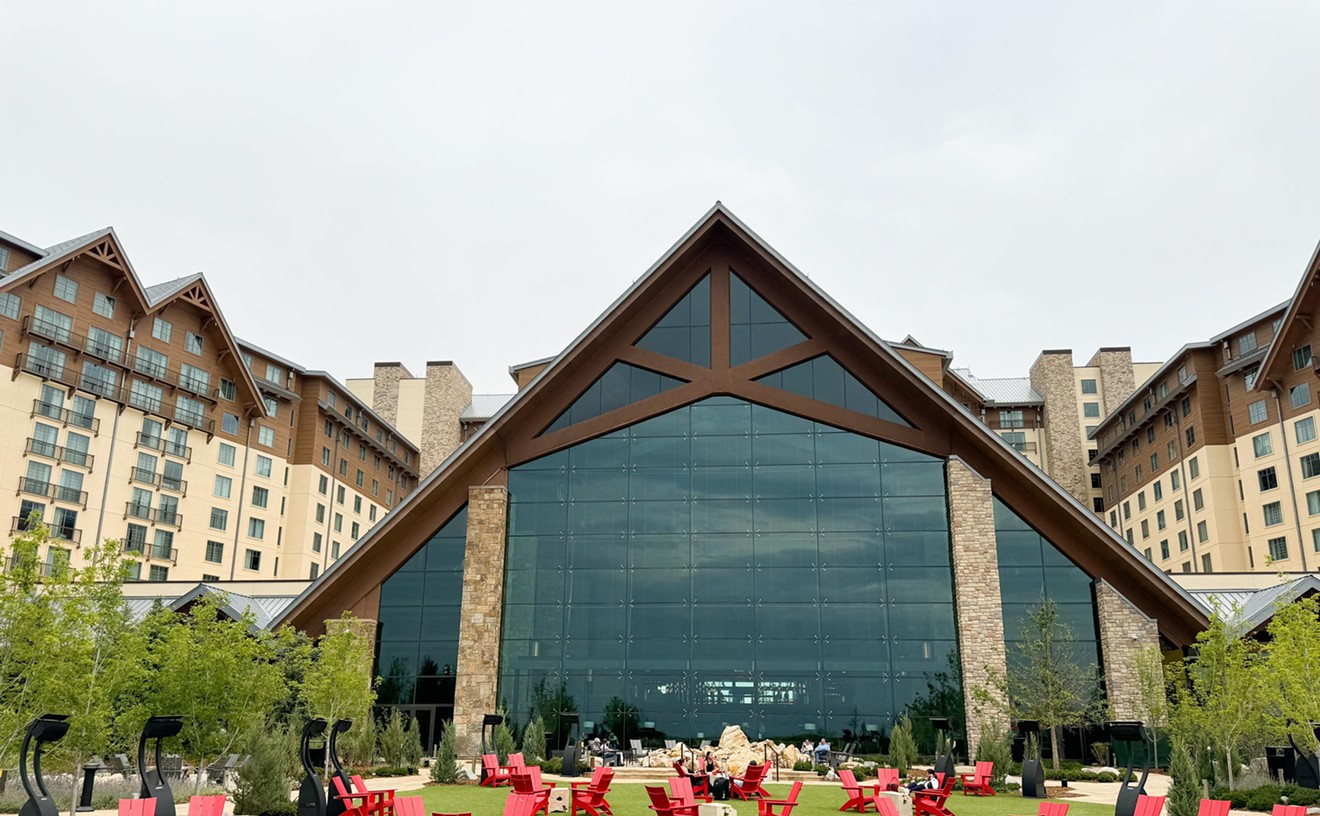When I was offered a tour of Lumina last week, I jumped at it. Although not my favorite new building in town, Lumina has done many things right where other developments have done so many wrong — especially on the Northside. It's a big structure for the neighborhood, but at five stories it's not anywhere close to some of the towering uglies popping up in other modest 'hoods. Lumina also has some style; the building's round edges and staggered terrace balconies give it a little Miami flair, and the interior is kinda like the Guggenheim — but less ornate and not nearly as filled with art. Still, the art is coming along — the common areas are dotted with hanging pieces and sparse contemporary furniture set-ups, as well as those old Pagliacci's neon signs installed throughout. (I'm a sucker for neon, and a white room filled with a florescent glow automatically means good ambiance to me.)
I was taken up to the building's third floor to check out the "community deck" that offers a very desirable view of downtown Denver and all of its cranes. It was beautiful! Lit from behind by the green neon of vintage "Italian Food" signs, the view at night must be even more breathtaking. But as I walked back to my car after the tour, it hit me: I had seen that same picturesque glimpse of the skyline before... from the Zitro "City View" Tavern, a half a block up from Lumina. Now, as I stood staring down from the Zitro parking lot, I could see only a sea of white where downtown had been: Lumina. This is the price of growth, I suppose. But what bothered me was that the view used to be free to anyone who happened into the area. Now that view only belongs to those who enter Lumina.
The same thing happened a few years ago when Linger's patio view of downtown was overtaken by a giant development. Linger was part of a development itself, of course; it was housed in a former piece of the Olinger mortuary business, which didn't really need a view, before it was given new life by Paul Tamburello and company a decade ago. The battle for views around town are waged by developers who can out-develop each other — but at least Tamburello is known for working with existing structures, not slapping up new ones that tower over the original buildings in the neighborhood.
I took the Baker Historic Home Tour this past weekend, an event that gives strangers a glimpse into private residences in one of Denver's oldest (and still intact) neighborhoods. When I stood on the balcony of an addition to one of these turn-of-the-last-century homes, I could see into many other yards on the block. But that was about as far as encroaching development gets in Baker; it is one of the few sections of the city not infested with bulbous build-outs and towering apartment complexes with trendy one-word names. The market in Baker is just as "hot" as anywhere else in Denver, but developers haven't been able to abuse the word "luxury" to sell their land-grabs quite as much as in other neighborhoods, like that fictitious place known as LoHi, where Linger resides.
The point is, this kind of thing occurs everywhere, all of the time. It's part of the expansion of any city. As many a blowhard has pointed out on my numerous Facebook postings about the changes I see in my city, it's happened before and it will happen again. The buildings and spaces around Denver that I'm attached to are only directly related to my experience; my eyes only see what has been put in front of my generation of Denverites. I mean, there are schools built on old landfills, parks created over cemeteries and, as we are seeing with this latest boom, lots of airspace being filled in with apartment buildings. I think about Cheesman Park and Capitol Hill, which are as equally populated with high-rise cement freakshows from the '70s as they are with squatty blond-brick apartment complexes from the '40s and '50s. As Victorians are made to feel embarrassed next to latest-era Denver monstrosities in Curtis Park, I remember: Those brick and mortar homes aren't original to the land, either. Nothing is but the land itself.
The Denver I see in 2015 often feels like a cardboard cutout of an emerald city, one that has been placed over a quaint cowtown to cover up its unsightly lack of hipness. But as views are lost as living spaces are gained, my hope is that more developers see the value in the atmosphere that is already here. Not every vacant lot has to become a monolith — sometimes, less is more. No one owns the views in this town, but it would be nice if there were a few places left where we could enjoy the skyline together.
Be my voyeur (or better yet, let me stalk you) on Twitter: @cocodavies
[
{
"name": "Air - MediumRectangle - Inline Content - Mobile Display Size",
"component": "12017618",
"insertPoint": "2",
"requiredCountToDisplay": "2",
"watchElement": ".fdn-content-body",
"astAdList": [
{
"adType": "rectangle",
"displayTargets": "mobile"
}
]
},{
"name": "Editor Picks",
"component": "17242653",
"insertPoint": "4",
"requiredCountToDisplay": "1",
"watchElement": ".fdn-content-body",
"astAdList": [
{
"adType": "rectangle",
"displayTargets": "desktop|tablet"
},{
"adType": "rectangle",
"displayTargets": "desktop|tablet|mobile"
}
]
},{
"name": "Inline Links",
"component": "18838239",
"insertPoint": "8th",
"startingPoint": 8,
"requiredCountToDisplay": "7",
"maxInsertions": 25
},{
"name": "Air - MediumRectangle - Combo - Inline Content",
"component": "17261320",
"insertPoint": "8th",
"startingPoint": 8,
"requiredCountToDisplay": "7",
"maxInsertions": 25,
"watchElement": ".fdn-content-body",
"astAdList": [
{
"adType": "rectangle",
"displayTargets": "desktop|tablet"
},{
"adType": "rectangle",
"displayTargets": "desktop|tablet|mobile"
}
]
},{
"name": "Inline Links",
"component": "18838239",
"insertPoint": "8th",
"startingPoint": 12,
"requiredCountToDisplay": "11",
"maxInsertions": 25
},{
"name": "Air - Leaderboard Tower - Combo - Inline Content",
"component": "17261321",
"insertPoint": "8th",
"startingPoint": 12,
"requiredCountToDisplay": "11",
"maxInsertions": 25,
"watchElement": ".fdn-content-body",
"astAdList": [
{
"adType": "leaderboardInlineContent",
"displayTargets": "desktop|tablet"
},{
"adType": "tower",
"displayTargets": "mobile"
}
]
}
]











